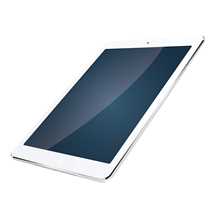$5 million NSF grant initiative leads to mobile physics instruction module
 Usually high school students take biology and chemistry before taking physics; yet, only 36 percent of students end up in physics courses, according to the American Institute of Physics.
Usually high school students take biology and chemistry before taking physics; yet, only 36 percent of students end up in physics courses, according to the American Institute of Physics.
Meera Chandrasekhar, a professor of physics at the University of Missouri, received a $5 million multi-year grant from the National Science Foundation (NSF) to address this challenge. She and her team developed a hands-on physics course for ninth graders designed to give them a better chance at being successful in higher-level high school and college-level science, technology, engineering and mathematics, or STEM courses.
The handheld tablet and computer-based curriculum application modules called “Exploring Physics” were developed through this grant and have just become available for instructors and students.
“Knowledge of science has changed dramatically in the past hundred years,” Chandrasekhar said. “Even the order in which classes are presented to students has been studied and evaluated. Biology has morphed into a technical, molecular study that combines elements of both chemistry and physics, so it’s logical that teaching physics first may have more of an impact. Through this grant, we were able to analyze and develop the practical tools science teachers can use in the classroom to help inspire students to higher accomplishments in STEM courses.”
The “A TIME for Physics First” Program is a collaboration among the University of Missouri and 37 school districts in Missouri, and other local colleges and organizations. The NSF Math-Science Partnership Institutes grant funded a teacher development program for 80 ninth-grade science teachers and provided summer academies and year-round support to enhance their physics knowledge and teaching methods.
Development of an inquiry- and modeling based experiential physics curriculum that could be used in the classroom, and the transformation of the paper-and-pencil curriculum to digital format, spearheaded by Chandrasekhar and Dorina Kosztin, teaching professor and associate chair of the Department of Physics and Astronomy in the College of Arts and Science at MU, were an integral part of the grant.
“In 2013, the most recent year for which data are available, about 84,000 ninth-graders took physics nationwide,” Chandrasekhar said. “Missouri students accounted for about 13,000 of them, of whom about 10,000 had been enrolled in MU’s Physics First Program.” The first group of students who took physics first entered college in 2013. While no data exist to document their success at the college level, it is already apparent that improvements are being made.
Chandrasekhar and her team examined student learning and technology self-efficacy gains among MU education majors in a physics course using the mobile-based Exploring Physics curriculum, which they developed through the NSF grant. Deepika Menon, a doctoral candidate in curriculum and instruction at MU, compared students using mobile curricula against those using more traditional science workbooks. She found that students using tablet-based technologies were more confident of using technology in their future classrooms.
“The Exploring Physics curriculum app, which was developed with the support of the National Science Foundation and in partnership with Werkz Publishing, is a wonderful resource for our partner districts and instructors,” Chandrasekhar said. “The mobile app was developed to provide teaching resources to instructors that address key physics concepts such as motion, forces, energy, electricity and waves. Based on pedagogies developed and refined through the grant, we’ve tested the curriculum on more than 10,000 students and over 100 teachers. Exploring Physics is an interactive curriculum where students can view animations, work with simulations, conduct labs, enter data, make graphs and drawings and then submit their work electronically for grading. The app allows students to learn anytime and anywhere without needing the internet continuously.”
Their presentation, “Examining the affordances of a mobile-based physical science curriculum for teaching and learning,” was given in July 2015 at the American Association of Physics Teachers Conference in Baltimore, Maryland. Their work was funded by the National Science Foundation (DUE 0928924). The content of the Exploring Physics curriculum is solely the responsibility of the authors and does not necessarily represent the official views of the funding agencies.
Editor’s Note: For more information, including a list of publications associated with this grant, please visit http://www.physicsfirstmo.org/.
For a list of the 39 partner districts, please visit http://www.physicsfirstmo.org/about/partners.php.
For information on the Exploring Physics Curriculum App, please visit: http://exploringphysics.com.
Material from a press release was used in this report.
- Friday 5: Virtual field trips - April 26, 2024
- Google, MIT RAISE launch no-cost AI training course for teachers - April 26, 2024
- 4 ways to support work-based learning - April 23, 2024
